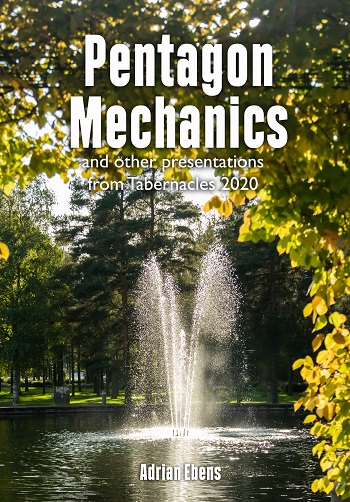Are SDA's Tritheists, by Glyn Parfitt
I have already written a detailed response to Mr. Parfitt's arguments respecting Tri-theism. If any one else is compelled to give it a go please feel free.
Written by Glyn Parfitt
Are Seventh-day Adventists Tritheists?
Having recently published an 850-page book answering objections to the Trinity,1 I recently received an email with the accusation that most Seventh-day Adventists are tritheists.2 Although I had devoted six pages of my book to argue strongly against tritheism,3 I was challenged because I had used the word being with reference to each Member of the Godhead. This was done because I felt that the overuse of the word person(s) could lead to a too-humanlike description of God.
For instance, I wrote, “Since there are thus two Persons or Beings who are both God, there is no reason why, in principle, there should not be a third Person or Being who has also eternally existed as God.”4
Is this tritheism?
The problem is that although careful Bible study gives us the basic concepts of the Oneness and the Threeness of God, this perusal of Scripture does not give us the words with which to describe these apparently paradoxical concepts. One possibility, found in Hebrews 1:3, refers to Christ being “the express image of his [the Father’s] person” (KJV). The word here translated “person” is hupostasis. However, this is the only place in the New Testament where hupostasis is translated “person.” Hupostasis has no really satisfactory English translation, as evident from the variety of ways the word is translated: person (KJV, NKJV); substance (RV); nature (RSV); being (NIV).
According to Robert Letham, Basil the Great (a.d. 330–379) is the first Christian writer to use hupostasis to emphasize the distinctness of the Members of the Godhead. Basil’s usage denotes that “God is three, thereby opening the way to speak of the Trinity in clearer language.”5
This terminology was taken up by others and used at the First Council of Constantinople (a.d. 381), where the following statement was made: “According to this faith there is one Godhead, Power and Substance of the Father and of the Son and of the Holy Ghost; the dignity being equal, and the majesty being equal in three perfect hypostases, i.e. three perfect persons.”6
In English, as in the above quotation, the concept of “three hupostases” has traditionally been expressed as “three persons.” Thus, we have the hymn referring to “God in three persons.” For reasons that we will shortly see, most Trinitarian writers will not speak of “three beings,” but at least one defender of Trinitarianism has been prepared to argue, “The admission of three infinitely perfect Beings does not at all imply the existence of more Gods than one.”7
Although Greek had one term that could refer to the Threeness of God, it had no suitable term with which to express the Oneness of God. Instead, Greek Christians appear to have borrowed a term from the Gnostics,8 homoousios, which is composed of two parts, homo and ousios, literally meaning the “same substance” or “same essence.” This term first came into prominence at the First Council of Nicea in a.d. 325, and Eusebius, the church historian, who was present at the council, found it necessary to explain the adoption of this term, homoousios, to his constituency at Caesarea.9
Although the Greeks felt justified in using hupostasis and homoousios when referring to the Threeness and the Oneness of God, Scripture does not tell us whether they were correct in using these terms the way they did.
Further questions arose when attempts were made to translate these two words into other languages. The English scholars have traditionally used “person” for hupostasis and the phrase “of one substance” for homoousios. Are these the best expressions to use when describing the Threeness and the Oneness of God, and where does the term being fit in? Scripturally, we do not have enough data to be sure.
The problem with the use of the term being seems to date back to the time of Augustine, who wrote a rather famous book on the Trinity. Augustine wrote in Latin, and we are reading it in the English translation, but we can still see what he did. Augustine first explains the use of the term persons saying, “Yet when you ask ‘Three what?’ human speech labors under a great dearth of words. So we say three persons, not in order to say that precisely, but in order not to be reduced to silence.”10
Augustine also explains why he will not speak of “three beings.” Among other things, he says, “By ‘being’ I mean here what is called ousia in the Greek, which we more usually call substance.”11 With this definition in place, he went on to say, “we do not call these three together one person, as we call them one being and one God, but say three persons while we never say three Gods or three beings.”12
While there may be some justification for what Augustine did in Latin, his use of “being” instead of “substance” has caused great confusion, as English theologians appear to have followed his lead in this matter. For instance, note the following from a recently published book: “However we may and surely must say that the Three Persons are integrated in the One Being and the One Being is integrated in the Three Divine Persons, such that there is no One Being apart from the Three Persons, and there are no Three Divine Persons apart from the One Being.”13
This kind of language, speaking of the Trinity as “One Being,” is confusing to the ordinary reader because, in the English language, the word being is used in three quite different ways. First, it is most frequently used as a participle, as in the following verse: “Then Joseph her husband, being a just man, and not willing to make her a public example, was minded to put her away privily” (Matt. 1:19, KJV). Second, it is used as an abstract noun, synonymous with the word existence, as we find in Acts: “For in him we live, and move, and have our being” (Acts 17:28, KJV; emphasis added). Third, it is used as a concrete noun meaning an intelligent form of life, such as a human being, angelic being, or Divine Being. Used in this sense, the word being is much closer to the meaning of “person” than to “substance” or ousia.
Now when a numeral is placed before the word being, as in “one being,” or “three beings,” the ordinary reader becomes fixed on the third of the above meanings, a concrete noun. The result is that when an author says that the Three Persons of the Godhead are “One Being,” the ordinary reader can see only an expression of modalism. This heresy, one of the earliest in the Christian church, teaches that only One Divine Being exists who reveals Himself sequentially in one or other of three modes, Father, Son, and Holy Spirit.
Evidence seems to say that the cause of Trinitarianism would have been better served had English theologians been content to keep with the creedal statement, “of one substance,” 14 instead of following the path laid down by Augustine. Letham observes, “Today most Western Christians are practical modalists.”15 He further states, “Colin Gunton has argued that the tendency toward modalism, inherited from Augustine, lies at the root of the atheism and agnosticism that has [sic] confronted the Western church in a way that it has not done in the East.”16
Ellen White insights
Sadly, there is no sure scriptural way out of this dilemma, for the Bible does not give us the words with which to express the Threeness and the Oneness of God. Seventh-day Adventists can, therefore, be thankful that where the biblical revelation leaves off, the Spirit of Prophecy, through Ellen White, comes to our aid and gives us some wonderful descriptions, not only of the Threeness, but also of the Oneness of God. We will take the primary oneness statement first, a statement she made in 1893. “Jesus said, ‘I and my Father are one.’ The words of Christ were full of deep meaning as he put forth the claim that he and the Father were of one substance, possessing the same attributes.”17
While Ellen White certainly followed the “of one substance” statement with the expression “possessing the same attributes,” no implication exists that the latter exhausts the meaning of the former. It’s true that “possessing the same attributes” must be part of what is meant by “of one substance,” but it is only a part, as she herself indicates by the preceding expression “full of deep meaning.”
The phrase “of one substance” was very common among biblical commentators in Ellen White’s day. A search using Google’s Advanced Book Search returned approximately 19,000 results for books in the Google files, published between 1700 and 1893, with the exact phrase “of one substance.” A quick scan showed that most of these instances were descriptions of the Godhead. Four samples will suffice:
The Anglican Book of Common Prayer: “And in Unity of this Godhead there be Three Persons, of one Substance, Power, and Eternity.”18
M’Gavin, quoting the Scottish Presbyterian Reformer, John Knox: “I offer myself without further delay to prove that Jesus Christ is of one substance with the Father.”19
William Robinson, on the phrase “of one substance with the Father,” says, “This phrase was adopted by the Nicene council. Those who would accept it were reputed orthodox; those who would not, were reputed heretics.”20
In the final example, the Adventist writer A. T. Jones provides an additional detail concerning the Council of Nicea:
Eusebius, bishop of Nicomedia, was chief of the Arians who held seats in the council [of Nicea]. At this point a letter was brought forth, which he had formerly written, in which he had stated that “to assert the Son to be uncreated, would be to say that he was ‘of one substance”—Homoousion—with the Father, and to say that “He was of one substance” was a proposition evidently absurd.
This gave to the party of Alexander and Athanasius the very opportunity which they desired; it supplied from the opposite party the very word upon which they had all the time insisted, and one of the chiefs of that party had declared that the use of the word in that connection was evidently absurd. If they, therefore, should insist upon the use of that very word, it would certainly exclude the Arian party.21
These remarks by Jones were part of his extensive treatise, The Two Republics, published in 1891, in which he details the theological events around the rise of the papacy and also gives a verbatim report of his representations to a government committee, by which he succeeded in averting the introduction of a national Sunday law in America. These things would have been of vital interest at that time, and the negative publicity given to the phrase “of one substance” would thus have become rather widely known.
That Ellen White published her “of one substance” statement just two years after that of Jones is significant. She could hardly have been unaware that her readers would recognize this phrase “of one substance” as the hallmark of Trinitarian orthodoxy. We should be particularly grateful that she penned this marvelous statement, “of one substance,” and placed it in the widely read magazine, Signs of the Times, in 1893, for it stands as a mighty bulwark against tritheism.
As far as I know, it is the only statement, in such a summary form, of the Oneness of the Godhead that has been revealed to us. Although this statement is all that is necessary, there are other significant statements as well.
While we can be thankful for Ellen White’s classic statement of the Oneness of God, we can also be thankful for the descriptions of the Threeness of the Godhead that were revealed to her. A number of such statements were made in 1900:22
• “The three great powers in heaven are witnesses . . . the pledge from the three persons— the Father, the Son, and the Holy Spirit.”23
• “You made a pledge in the presence of the Father, the Son, and the Holy Spirit—the three great personal Dignitaries of heaven.”24
• “The three great and glorious heavenly characters are present on the occasion of baptism.”25
• “There are three living persons of the heavenly trio . . . the Father, the Son, and the Holy Spirit.”26
• “You are born unto God, and you stand under the sanction and the power of the three holiest beings in heaven, who are able to keep you from falling.”27
• “I just call upon the three great Worthies, and say: You know I cannot do this work in my own strength.”28
What a wonderful variety of words referring to the Threeness of the Godhead are revealed to us in the writings of Ellen White: Agencies, Powers, Persons, Instrumentalities, Dignitaries, Characters, Beings, and Worthies.
By comparing the dates of the above statements, we can see that more than six years passed after her landmark statement “of one substance,” before she began to emphasize in such a marked and specific way the Threefold nature of the Godhead. This is significant.
It was important that God’s people should be established on the Oneness of the Godhead as a barrier to tritheism, before she began to emphasize the other side of the paradox, the Threeness, as a protection against unitarianism, modalism, and, incidentally, much of today’s non-Trinitarianism.
Nor was it a matter of Ellen White having forgotten about the Oneness when writing of the Threeness, for interspersed with her Threeness statements are statements which preserve the Oneness, such as the following:
“Those who are baptized in the threefold name [singular] of the Father, the Son, and the Holy Spirit, at the very entrance of their Christian life.”29
“After we have formed a union with the great threefold power [singular], we shall regard our duty toward the members of God’s family with a much more sacred awe.”30
How well Ellen White has expressed the basic concept of the Trinity, a union of Oneness and Threeness, in these two passages.
Conclusion
So long a s Seventh-day Adventists hold to the classical statement endorsed by Ellen White, that the Persons of the Godhead are “of one substance,” they cannot rightfully be accused of being tritheists. Nor is there any valid reason why they should not use the term beings as a synonym for the word persons when referring to the Three Members of the Trinity.
Other Christian theologians would, I believe, gain greater credibility with their readers if they abandoned their Augustinian terminology and refrained from using the word being in reference to the Oneness of God.
1 Glyn Parfitt, The Trinity: What Has God Revealed: Objections Answered (Warburton, Victoria, Australia: Signs Publishing Company, 2008).
2 An article in Wikipedia makes a similar claim. See http://en.wikipedia.org/wiki/tritheism/ point 12, accessed Jan. 15, 2011.
3 Parfitt, 383–389.
4 Ibid., 367.
5 Robert Letham, The Holy Trinity: In Scripture, History, Theology and Worship (Philipsburg: P&R Publishing, 2004), 149.
6 Synodical Letter of the First Council of Constantinople: Christian Classics Ethereal Library, 189, as found at http:// www.ccel.org/ccel/schaff/npnf214.ix.ix.html/, accessed Dec. 27, 2010.
7 Timothy Dwight, Theology: Explained and Defended in a Series of Sermons, 7th ed. (New York: G. and C. Carvill, 1830), 2:8.
8 The Web site http://www.answers.com/topic/homoousian/, accessed Dec. 19, 2010, footnote 1 cites a number of scholars to this effect.
9 Eusebius, Letter to His Church at Caesarea. See H. M. Gwatkin, Selections From Early Christian Writers (London: James Clark & Co., 1958), 177–181.
10 Augustine, The Trinity, ed. Edmund Hill and John E. Rotelle (New York: New City Press, 1991), 197.
11 Ibid.
12 Ibid., 232.
13 Thomas F. Torrance, The Christian Doctrine of God, One Being Three Persons (London: T & T Clark, 1996), 24.
14 See Philip Schaff, The Creeds of Christendom, vol. 1, 456.
15 Letham, 5.
16 Ibid., 7 (referring to Colin E. Gunton, “Augustine, the Trinity, and the Theological Crisis of the West,” in Scottish Journal of Theology, 43 [1990]: 33–58).
17 Ellen G. White, Signs of the Times, Nov. 27, 1893, 54.
18 The Book of Common Prayer, Church of England, 1716, 1765, 1838, 1892, etc.
19 John Knox and William M’Gavin, The History of the Reformation of Religion in Scotland (Glasgow: Blackie & Son, 1832), 568.
20 William Robinson, Biblical Studies (London: Longmans, Green, and Co., 1866), 127.
21 A. T. Jones, The Two Republics: Or Rome and the United States of America (Battle Creek, MI: Review and Herald, 1891), 348, 349.
22 These statements together with additional similar statements may be seen in a larger context in Parfitt, 467–473.
23 Seventh-day Adventist Bible Commentary (Washington, DC: Review and Herald, 1957), 6:1074.
24 S.D.A. Bible Commentary, 7:959.
25 Ellen G. White, Manuscript 45, May 14, 1904, 10 (Manuscript Releases, 6:389).
26 SDA Bible Commentary, 7A:441–442.
27 Manuscript Releases, 7:267.
28 Ibid.
29 SDA Bible Commentary, 6:1075.
30 SDA Bible Commentary, 6:1102.




